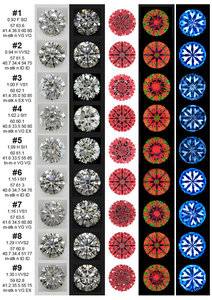kmoro
Brilliant_Rock
- Joined
- Sep 13, 2018
- Messages
- 1,083
Happy Easter Weekend!
Today I was doing the internet thing and found the following chart ... it made me feel better about my diamond’s 56.4% table (well, to be realistic, I stopped being concerned about it as soon as I saw the diamond is very fiery ... I still overthink things ...) ... sometimes was thinking about trying for that 55% table in the future (although not a giant leap from 56.4) ... thanks to PS ...and I believe that the smaller table produces more fire like everyone here says ... even just today learned a bit about the upper girdle facet relationship with the table size ... but what about this chart? Is it just another BS chart with a capital B and capital S that the experts here hate so much? I’m surprised that the smaller 53-55% tables are not included in the super-ideal range ... and that the depth is 61 - 62.5%.

https://www.petragems.com/education...cellent-ideal-cut-diamond-diamond-brilliance/
I am also really doubting my ability to see the difference between a smaller table (say 54%) vs a larger table (say 60%) and the respective fire, brilliance, scintillation, produced by each.
The Jann Paul videos refer to the contrast areas as the areas that produce fire (blue areas under the ASET scope) ... and it does appear that the colour flashes come off of these areas ... but from what I have read, it is still the crown facets that refract the light and “produce” the fire.
I’m thinking that the fire produced by any individual diamond is the combination of the light refraction from the crown and how that split light reflects off of the pavilion mains. So ... the combination of the two - the angle relationship of the two - would determine how the coloured light is produced and reflected back to the eye, right? Would this explain why some 60/60 stones still have great fire while some 55% table diamonds don’t? And those coloured flashes off the pavilion mains would also be affected by the lower half lengths (shorter LH would be bigger flash vs skinnier flash), right? ETA: does the light refract again when coming OUT of the upper facets?
I have noticed that 77% lower halfs seem to be the “safe spot” - what are the other factors that could make 70% or 85% undesireable? Is a large table with long lower half lengths bad or good, for example? Is it just personal preference or are some combos just automatically bad, as with crown angle and pavilion angle combos?
I’m still trying to figure out the effect of star length on light performance other than how it affects the size of the other facets, like the upper girdle facets - maybe there is no other isolatable effect and these things must necessarily be taken as a whole in regard to diamond performance? Can anyone tell me more?
I found this article on PS and taking the liberty of posting the link here ... for anyone new ... or anyone just wanting to look at an article about cut I guess. I liked this one for a lazy afternoon
Laboratory cut grades and what the report doesn’t show - by John Pollard.
https://www.pricescope.com/articles/laboratory_cut_grades_what_report_doesnt_show
ETA#2 .... this picture chart from the above article ... I can see how the 60/60 stones do look whiter with less contrast ... quite a bit less contrast. Hmmm.

Happy Saturday to you!
Today I was doing the internet thing and found the following chart ... it made me feel better about my diamond’s 56.4% table (well, to be realistic, I stopped being concerned about it as soon as I saw the diamond is very fiery ... I still overthink things ...) ... sometimes was thinking about trying for that 55% table in the future (although not a giant leap from 56.4) ... thanks to PS ...and I believe that the smaller table produces more fire like everyone here says ... even just today learned a bit about the upper girdle facet relationship with the table size ... but what about this chart? Is it just another BS chart with a capital B and capital S that the experts here hate so much? I’m surprised that the smaller 53-55% tables are not included in the super-ideal range ... and that the depth is 61 - 62.5%.

https://www.petragems.com/education...cellent-ideal-cut-diamond-diamond-brilliance/
I am also really doubting my ability to see the difference between a smaller table (say 54%) vs a larger table (say 60%) and the respective fire, brilliance, scintillation, produced by each.
The Jann Paul videos refer to the contrast areas as the areas that produce fire (blue areas under the ASET scope) ... and it does appear that the colour flashes come off of these areas ... but from what I have read, it is still the crown facets that refract the light and “produce” the fire.
I’m thinking that the fire produced by any individual diamond is the combination of the light refraction from the crown and how that split light reflects off of the pavilion mains. So ... the combination of the two - the angle relationship of the two - would determine how the coloured light is produced and reflected back to the eye, right? Would this explain why some 60/60 stones still have great fire while some 55% table diamonds don’t? And those coloured flashes off the pavilion mains would also be affected by the lower half lengths (shorter LH would be bigger flash vs skinnier flash), right? ETA: does the light refract again when coming OUT of the upper facets?
I have noticed that 77% lower halfs seem to be the “safe spot” - what are the other factors that could make 70% or 85% undesireable? Is a large table with long lower half lengths bad or good, for example? Is it just personal preference or are some combos just automatically bad, as with crown angle and pavilion angle combos?
I’m still trying to figure out the effect of star length on light performance other than how it affects the size of the other facets, like the upper girdle facets - maybe there is no other isolatable effect and these things must necessarily be taken as a whole in regard to diamond performance? Can anyone tell me more?
I found this article on PS and taking the liberty of posting the link here ... for anyone new ... or anyone just wanting to look at an article about cut I guess. I liked this one for a lazy afternoon
Laboratory cut grades and what the report doesn’t show - by John Pollard.
https://www.pricescope.com/articles/laboratory_cut_grades_what_report_doesnt_show
ETA#2 .... this picture chart from the above article ... I can see how the 60/60 stones do look whiter with less contrast ... quite a bit less contrast. Hmmm.

Happy Saturday to you!
Last edited:




300x240.png)